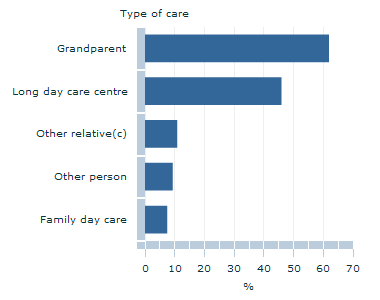Page tools:
 Print Page Print Page
 Print All Print All
| |||||
|
CONTENTS Article - Introduction - Working while pregnant - Taking maternity leave - Perceived discrimination while working during pregnancy - How long were women away from work? - Partners' leave arrangements - Returning to work - Flexible work arrangements - Partners' work arrangements - Looking ahead Additional topics - Who is looking after the children? Explanatory information - Data sources and definitions - Endnotes EMPLOYED MOTHERS(a), SELECTED MAIN REASON RETURNED TO WORK, NOVEMBER 2011  Footnote(s): (a) Mothers of a child aged less than two, includes mothers who did not have a job while pregnant. Source(s): ABS Pregnancy and Employment Transitions, November 2011 Related terms: pregnancy and work, pregnancy and working, pregnancy at work, pregnancy discrimination, paid parental leave, paternity leave Australia, working while pregnant, first time mother, baby bonus, the baby bonus, Australia baby bonus, flexible work arrangements, dad and partner pay, child care INTRODUCTION The birth of a child is a momentous occasion in any family. While generally a positive and happy time, it also marks a period of significant change. For employed expectant mothers, the transition between paid work and having a baby can be difficult to navigate. Decisions about returning to work are influenced by both financial and family issues, as well as the availability of flexible work arrangements and appropriate child care. On the 1st of January 2011, the Commonwealth Government introduced a Paid Parental Leave scheme for eligible working parents, providing an opportunity for families to take the time to care for their newborn child, and recognising the critical role of women in Australia's labour force. While the scheme may ease the financial pressures of becoming a new parent, mothers still face numerous challenges during this period. This article examines the work transitions of mothers before and after the birth of their child. Unless otherwise stated, 'Mothers' refers to birth mothers aged 15 years and over who had a child aged under two at the time of the survey. See Data sources and definitions for more information. WORKING WHILE PREGNANT In November 2011, there were 523,300 mothers in Australia with a child aged less than two. Over two thirds (68% or 357,500) of these women had a job during their pregnancy, and almost all of these women (98%) worked in their job at some stage while they were pregnant, while just 2% did not work in that job during their pregnancy. Of the mothers who had a job during their pregnancy and were working immediately before the birth, almost half (48%) worked part-time immediately before stopping work for the birth of their child. First time mothers were less likely to work part-time (25%) than mothers who already had a child (69%). EMPLOYED MOTHERS(a) PERCENTAGE WHO WORKED FULL OR PART-TIME(b)(c) BY WHETHER BABY WAS FIRST CHILD IN FAMILY, NOVEMBER 2011  Footnote(s): (a) Mothers of a child aged less than two. Excluded mothers who did not work in their job during pregnancy and mothers who permanently left their job before the birth of their child. (b) Part-time hours includes people who usually worked less than 35 hours a week, full-time hours includes mothers who usually worked 35 hours or more per week. (c) Full or part-time hours worked immediately before birth. Source(s): ABS Pregnancy and Employment Transitions, November 2011 Less than half (46%) of younger mothers aged 15-24 had a job while they were pregnant. This was less than mothers in older age groups, with almost three quarters (74%) of mothers aged 30-39 having a job while pregnant. Women in the younger age group are often in a transitional stage between education and work, and are more likely to be studying than those in the older age groups, which will impact on their participation in the work force before and after the birth of their child. PERCENTAGE OF MOTHERS(a) WHO HAD A JOB WHILE PREGNANT BY AGE(b), NOVEMBER 2011 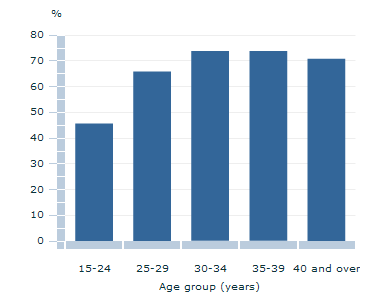 Footnote(s): (a) Mothers of a child aged less than two. (b) Includes mothers who did not work in their job during pregnancy. Source(s): ABS Pregnancy and Employment Transitions, November 2011 Over one quarter (29%) of mothers who had a job during their pregnancy permanently left their job either before or after the birth of the child. Almost half (49%) of these women left their job specifically to care for their child, while 11% left as it was a temporary job or employment. TAKING MATERNITY LEAVE In Australia, all employees are eligible for unpaid parental leave if they have completed at least 12 months of continuous service with their employer. This entitlement includes a guarantee of returning to their pre-parental leave position (or, if the position no longer exists, an alternative position that is suitable, and which is nearest in status and pay to their pre-parental leave position).1 For pregnant employees, this leave can start up to six weeks before the expected date of birth, or earlier if both employee and employer agree.1 In November 2011, despite being able to take parental leave earlier, over a third (37%) of mothers who worked during pregnancy had started maternity leave one week or less before the birth of their child. While in some cases the birth of their child may have come earlier than expected, some women may also have decided to delay the start of maternity leave until further into their pregnancy, to maximise time on leave after the birth. The impact of paid leave entitlements Of mothers who worked in a job while pregnant, those who were employees with paid leave entitlements were more likely to stop work sooner rather than later, with over half (53%) stopping work four or more weeks before the birth of their child. Almost one third (29%) of those with paid leave entitlements worked until one week or less before the birth. In contrast, over half (56%) of those employees without paid leave entitlements (often referred to as casual employees) started maternity leave one week or less before the birth of their child. Similarly, over half (56%) of mothers who were working in their own or a relatives' business while pregnant worked until one week or less before the birth of their child. Mothers in the private sector kept on working Mothers working in the private sector were twice as likely to leave at one week or less before the birth of their child (41%) than those working in the public sector (21%). This is likely due to the higher availability of paid leave entitlements in the public sector and the greater incidence of casual work in the private sector. MOTHERS(a) WHO HAD A JOB WHILE PREGNANT(b), NUMBER OF WEEKS STOPPED WORK BEFORE BIRTH OF CHILD(c) BY SECTOR, NOVEMBER 2011 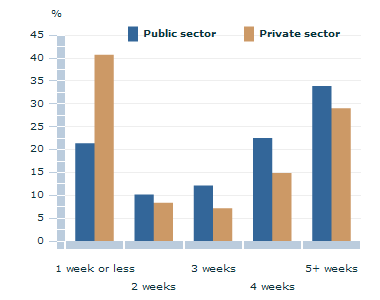 Footnote(s): (a) Mothers of a child aged less than two. (b)Who worked in their job while pregnant. (c)Includes women who permanently left their job before the birth. Source(s): ABS Pregnancy and Employment Transitions, November 2011 Type of leave Many employees had access to paid and/or unpaid parental leave prior to the national Paid Parental Leave (PPL) scheme, typically provided by their employer through workplace agreements and industrial awards, as well as legislation for public sector employees.2 Furthermore, parents (including those not working) had access to the Baby Bonus if they met the relevant eligibility requirements.3 Since the introduction of the PPL scheme in January 2011, all employed mothers have had access to Parental Leave Pay (PLP) if they met certain eligibility requirements.4 Parents could apply for either PLP or the Baby Bonus (not both) per child. According to the Paid Parental Leave Evaluation,5 of mothers who had babies in 2011-12 (including adoptive parents), around 44% received PLP and 55% received the Baby Bonus (with some receiving both due to multiple births). Mothers who took PPL were more likely to be in permanent or ongoing employment (80%) than those who received the Baby Bonus (51%), while mothers who took the Baby Bonus were more likely to have been self-employed (14%) than those who took PPL (4%). In 2011-12, 17% of mothers who were likely to be eligible for PLP chose to take the Baby Bonus instead. These mothers were more likely to already have children in their household, and more likely to be experiencing some sort of disadvantage (e.g., more likely to be single mothers or have low incomes, more likely to be working on casual contracts before the birth) than mothers who chose to take PLP.5 Employees In November 2011, 80% of mothers who worked as employees while they were pregnant had access to paid leave entitlements in their job. Half (49%) of those with paid leave entitlements took a combination of paid and unpaid leave for the birth of their child, while smaller proportions took paid leave only (20%) or unpaid leave only (10%). The remainder either permanently left their job before the birth (18%), while a small proportion did not take any leave (2%). Employees without paid leave entitlements were much more likely than those with paid leave entitlements to take no leave before the birth (22% compared to 2%) and were more than twice as likely to leave their job before the birth (44% compared to 18%). PERCEIVED DISCRIMINATION WHILE WORKING DURING PREGNANCY In November 2011, around one in five (22%) mothers who were employees who worked in their job while pregnant felt that they had experienced some type of discrimination in their workplace during their pregnancy. Most (91%) felt that this was a direct result of their pregnancy. Of those who felt they had experienced discrimination, the most common types of discrimination were receiving inappropriate or negative comments, either from a manager/supervisor or colleague (37%), missing out on opportunities for promotion (34%) or training or development opportunities (32%). MOTHERS(a) WHO PERCEIVED DISCRIMINATION WHILE WORKING DURING PREGNANCY(b), SELECTED PERCEIVED DISCRIMINATION(c), NOVEMBER 2011 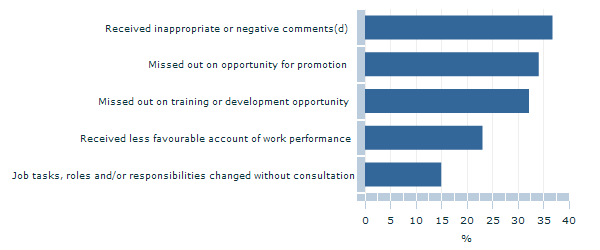 Footnote(s): (a) Mothers of a child aged less than two who were employees. (b) Excludes women who did not work in their job while pregnant. (c) Multiple response category, combined percentages may equal more than 100%. (d) From a manager/supervisor and/or colleague. Source(s): ABS Pregnancy and Employment Transitions, November 2011 HOW LONG WERE WOMEN AWAY FROM WORK? The average length of leave mothers took from their job for the child's birth and subsequent care (until the mother returned to or joined the workforce, or until the date of survey) was 32 weeks. On average, mothers aged 35 and over had taken longer leave than younger mothers. Of those who took paid leave only, mothers aged 35 and over had taken on average almost twice as many weeks (20 weeks) of paid leave than younger mothers aged 15-29 (11 weeks). When mothers took unpaid leave only, there was little difference in the duration of leave by age, with an average of 25 weeks of leave. MOTHERS(a) WHO HAD A JOB WHILE PREGNANT(b), AVERAGE NUMBER OF WEEKS LEAVE(c) BY AGE OF MOTHER, NOVEMBER 2011  Footnote(s): (a) Mothers of a child aged less than two. Excludes women who did not work in their job while pregnant and those who permanently left their job before birth of child. (b) Mothers who took leave for the birth of their child. (c) Average number of weeks away from job until the mother returned to their job or joined the workforce after the birth of the child, or until the date of interview. (d) Includes paid leave taken at full-pay and half-pay. (e) Includes women who took a combination of paid and unpaid leave. Source(s): ABS Pregnancy and Employment Transitions, November 2011 PARTNERS' LEAVE ARRANGEMENTS Partners have an important role to play following the birth of a child, particularly in the early weeks. Being able to spend time away from work and bond with a new baby, as well as providing emotional and physical support for mums, are just some of the reasons why partners may take leave. In November 2011, most (89%) mothers who had worked in a job while pregnant had a partner who was also working while she was pregnant. Four out of five (81%) of these partners took leave for the birth of the child. Of those partners who took leave, nearly two thirds (63%) took paid leave only, while a third (33%) took unpaid leave only. The remainder took a combination of both paid and unpaid leave. Generally, the duration of partners' leave was relatively short. Of the partners who took leave from their job for the birth of the child, 70% had returned to work within two weeks. Nearly three quarters (73%) of partners employed in the private sector during the pregnancy took two weeks or less leave compared with half (50%) of partners employed in the public sector. Partners employed in the public sector were three times as likely (22%) to take five weeks or more leave than those in the private sector (7%), probably due to greater leave entitlements. PARTNERS'(a) DURATION OF LEAVE(b) FOR BIRTH OF CHILD BY SECTOR OF EMPLOYMENT, NOVEMBER 2011 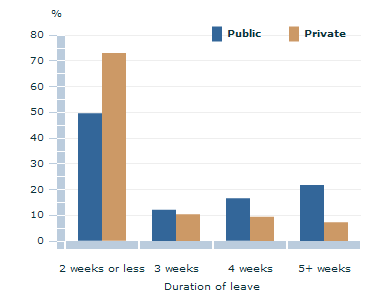 Footnote(s): (a) Partners of mothers of a child aged less than two who worked in a job while pregnant. (b) Excludes partners who did not take leave. Source(s): ABS Pregnancy and Employment Transitions, November 2011 RETURNING TO WORK There are a range of factors that need to be considered by mothers returning to work after having a baby. Workplace flexibility, the availability of quality child care, maintaining a connection with paid work, and financial considerations all play a part. In November 2011, over half (53%) of mothers of a child under two who had a job while pregnant had returned to the workforce, while 13% were on either paid or unpaid leave following the birth of their child. The remainder had not returned to work, with most (88%) reporting that they had not returned to work in order to care for their child. In addition to the 190,000 mothers who had a job while pregnant and had returned to work after the birth of their child, there were a further 16,000 mothers who did not have a job while pregnant who started working after the birth of their child. The average age of their child when they started or returned to work was 28 weeks. Why do women return to work? Although family considerations do play a part in decisions related to returning to work, the most commonly reported main reason given by mothers who started or returned to work was in order to keep their job or their employer had requested their return (26%). This was followed by financial considerations (15%) and maintaining self esteem (15%). FLEXIBLE WORK ARRANGEMENTS Flexible work arrangements are not only beneficial for individual mothers and their families. Research has found that women employed in highly flexible roles are more productive than the rest of the working population.6 Organisations that fail to provide flexible arrangements may be missing out on the opportunity to harness the skills, experience, and productivity of women who need to balance work and family responsibilities. Flexible arrangements may be in the form of part-time work or flexible work hours, working from home, shift work, job share or leave arrangements. In November 2011, most mothers (86%) who had started or returned to work following the birth of their child used flexible work arrangements in their first job returned to in order to care for their child. While many mothers worked part-time when they started or returned to work, not all considered part-time work as a flexible arrangement to care for their child. However, working part-time was the most commonly reported flexible work arrangement for mothers returning to work (65%). Over a third (35%) of mothers returning to or starting work after the birth of their child made use of flexible work hours, while a quarter (26%) worked from home. Women who worked in part-time roles were almost twice as likely to use flexible arrangements (93%) than those working full-time (48%). Of the 15% of mothers who did not use flexible arrangements in their first job since the birth, around half (49%) did not have access to these arrangements. EMPLOYED MOTHERS(a), TYPE OF FLEXIBLE ARRANGEMENTS USED(b) TO ASSIST WITH CARE OF CHILD(c), NOVEMBER 2011 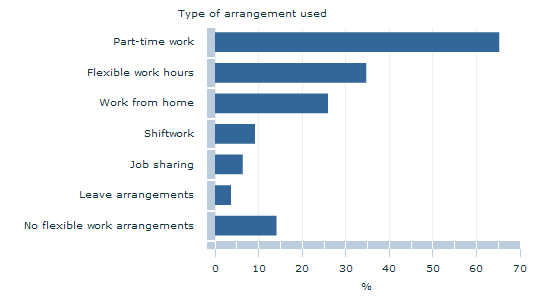 Footnote(s): (a) Mothers of a child aged less than two. (b) In first job since birth of child. (c) Multiple response category, total may not equal 100%. Source(s): ABS Pregnancy and Employment Transitions, November 2011 Working part-time Over four out of five (84%) mothers who started or returned to work following the birth of their child worked part-time in their first job returned to, with three quarters (75%) of these women using part-time work specifically to care for their child. Many women worked part-time before the birth of their child, though the number of hours worked changed considerably. In November 2011, only 10% of women with a child under 2 who worked during their pregnancy usually worked fewer than 15 hours per week immediately before stopping work. In contrast, 39% of mothers returning to or starting work after the birth worked these hours when they first returned to work, with 45% working between 15 and 34 hours per week on average. HOURS USUALLY WORKED BY MOTHERS(a) IMMEDIATELY BEFORE(b) AND IMMEDIATELY AFTER(c) BIRTH OF CHILD, NOVEMBER 2011 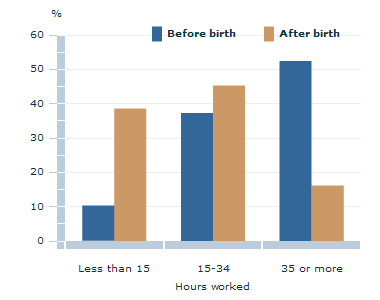 Footnote(s): (a) Mothers of a child aged less than two. (b) Hours worked immediately before birth. Excludes women who did not work in their job during pregnancy, or did not have a job while pregnant. (c) Hours worked in first job since returning to work. Includes women who returned to work or started work following the birth. Source(s): ABS Pregnancy and Employment Transitions, November 2011 ...changes as the child gets older The proportion of women working fewer than 15 hours per week reduced as children got older. In November 2011, almost half (48%) of mothers of a child aged 0-6 months who had started or returned to work usually worked less than 15 hours per week in their job. This decreased to 22% for mothers of children aged 19-24 months. PARTNERS' WORK ARRANGEMENTS In addition to mothers using flexible work arrangements, partners may also use flexible arrangements in their job to help care for their child. High levels of father involvement are associated with better outcomes for children and families,7 and having a partner with flexible work arrangements may help mothers to balance their own work commitments. In November 2011, there were 188,000 couples in which both the mother and her partner had started or returned to work after the birth of the child. Of these partners, 29% had used flexible work arrangements in their first job since the birth to assist with care. The most common arrangement used was flexible work hours, with around one in five (19%) partners accessing these arrangements. One in ten partners (10%) worked from home. Of the partners who did not use flexible work arrangements to assist with the care of their child, half (51%) had no access to flexible arrangements. Almost a third (31%) had flexible arrangements at their workplace but did not use them, while the remainder did not know whether flexible arrangements were available for them to use. While social norms around the role of fathers and their level of involvement with caring for their children may be changing, it appears that in many families, managing work and child care often still depends on fathers working full-time while mothers work part-time.8 LOOKING AHEAD It appears that while many partners have had access to paternity leave and/or flexible work arrangements, the uptake of these arrangements has not been wide spread. The introduction of government funded Dad and Partner Pay9 aims to help support eligible partners to take time off work to spend with their new child, as well as taking a larger share of caring responsibilities. Ensuring that women do not face discrimination because of pregnancy or parental leave is important in helping mothers to maintain their connection to the labour force. The Australian Human Rights Commission is currently investigating the extent and nature of discrimination against women who are pregnant at work, as well as parents returning to work after parental leave.10 ADDITIONAL TOPICS EXPLANATORY INFORMATION ENDNOTES 1. Australian Government Fair Work Ombudsman Parental leave and related entitlements and the National Employment Standards viewed 30 September 2013 <www.fairwork.gov.au> 2. Ray Broomhill and Rhonda Sharp, August 2012 Australia’s parental leave policy and gender equality: an international comparison <www.adelaide.edu.au> 3. Australian Government Department of Human Services Baby Bonus viewed 30 September 2013 <www.humanservices.gov.au> 4. Australian Government Department of Human Services Having a baby or adopting a child viewed 30 September 2013 <www.humanservices.gov.au> 5. Institute for Social Science Research Paid Parental Leave Evaluation: Phase 2 Report viewed 1 November 2013 <www.dss.gov.au> 6. Amy Poynton and Louise Rolland, July 2013 Untapped opportunity: The role of women in unlocking Australia's productivity potential <www.wgea.gov.au> 7. Katherine R Wilson and Margot R Prior, June 2010 Father involvement and child well-being <onlinelibrary.wiley.com> 8. Natalie Skinner, Claire Hutchinson and Barbara Pocock, August 2012 The Big Squeeze: Work, home and care in 2012 <www.unisa.edu.au> 9. Australian Government Department of Human Services Dad and Partner Pay viewed 30 September 2013 <www.humanservices.gov.au> 10. Australian Human Rights Commission Pregnancy discrimination viewed 30 September 2013 <www.humanrights.gov.au> Document Selection These documents will be presented in a new window.
|
||||
4102.0 - Australian Social Trends, Nov 2013
ARCHIVED ISSUE Released at 11:30 AM (CANBERRA TIME) 20/11/2013
This page last updated 17 March 2014

